Cities by the sea: six great beach towns in Europe
Cádiz, Spain
It was a real pigeon’s eye view. The guide atop Cádiz’s Torre Tavira (€6) manoeuvred the concave viewing dish up, down and around, showing us watchtowers, churches, palaces, dockyards – and dozens of roof terraces with flapping laundry. The camera obscura at the top of this 45-metre tower, the tallest of 129 built in the 1700s for observing merchant ships, is a perfect introduction to Spain’s most ancient city, and in particular its maritime position, with sea on three and a half sides.
This camera obscura makes ingenious use of magnification and mirrors, but it is helped enormously by the intense light in this city, capital of Spain’s Costa de la Luz. Cádiz is also nicknamed tacita de plata – silver cup – for the way the westering sun glints off the sea; it also makes the white marble west face of Santa Cruz cathedral glitter like a disco ball.
What’s also obvious from the tower is that Cádiz is a perfect destination for those who like sea and sand but also a bit of urban buzz. Right in the old town, La Caleta is the smallest city beach, but still 450 metres long, and lovely enough to stand in for Havana in Die Another Day (Halle Berry, binoculars, orange bikini). A stroll to the south, Santa Maria beach is a family favourite, with calm water and a couple of chiringuitos (beach bars) on wide pale sand between two breakwaters.
And these are just a curtain raiser for the four miles of unbroken sands stretching on south, starting with La Victoria (bus 1 or 7 from the old town), preferred by many young gaditanos, offering chiringuitos, pedalos, beach sports, outdoor cinema on the beach, and lots of bars and clubs on the prom behind.
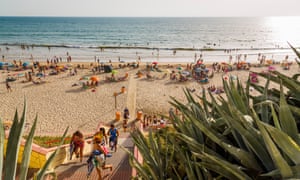
As recently as 15 years ago Cádiz was a dodgy place, known more for drugs and prostitution than tapas and boutique hotels. Things have changed a lot, but not to the extent that tourism pushes locals’ lives to the margins. Just minutes from the cathedral square the narrow streets are home to low-key bars and greengrocers, and a historic covered market dealing mainly in fish and seafood such as oysters dredged that morning. The sea views from parks and tree-filled squares loud with birdsong are simple pleasures, but don’t miss sights such as the oldest Roman amphitheatre in Spain(entrance on Calle Meson, free); two fortresses, San Sebastián and Santa Catalina, flanking La Caleta with art exhibitions and great views back to the city; and the Beaterio catacombs (€6) for a sobering view of Cádiz life and death in centuries past.
Where to eat
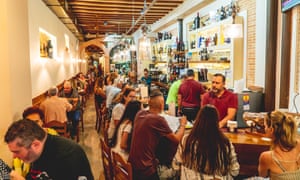
Tapas is the way to go, with the option in many places of “supersizing” to a media racione. Cádiz doesn’t quite have a gay quarter, but our guide, dancer Sam Gordillo Conejo, took us to its “gay corner” and purple-painted, David Hockney-decorated tapas bar La Gorda te da de Comer (the fat woman feeds you. Tapas such as salmorejo tomato dip and bright green spinach croquetas cost from €2. Restaurante Balandro, facing north over the bay, is altogether posher, but sit up on high stools at the back bar and you eat the same food (small plates from €5) as in the main restaurant. In the evening, get to locals’ favourite Taperia de Columela before the 9pm rush for interesting tapas such as aubergine “chips” and tuna lasagne (about €18 for two including a glass of wine).
Where to stay
Near the cathedral, Casa Nautilus is a converted period house with central atrium, roof terrace and 15 rooms, some with traditional glassed-in balconies (doubles from €59, room-only, but help-yourself coffee, tea and biscuits). Owned by the same people, the Spanish Galleon is more hostel-style (doubles with shared facilities from €35, apartments from €65). It has amazing views from its large roof terrace, and a new ground-floor cafe doing breakfasts from €2 and a €6 vegan lunch.
Getting there
Trains run to Cádiz from London via Paris, Perpignan (sleeper) and Madrid. See loco2.com for details.
Liz Boulter
Toulon, France

The Côte d’Azur feeling starts soon after the eastbound train leaves Marseille: pale pink houses with apricot-coloured roofs, sharp spires of cypress trees, blue sea glimpsed through the spreading branches of umbrella pines. The line runs on to the millionaire playgrounds of Cannes and Monaco, but its first stop is Toulon, capital of the less-frequented and more affordable western Riviera.
Founded by the Romans and a major naval base since the 15th century, Toulon also happens to have the warmest and sunniest climate in mainland France, and beaches of all kinds along 30 miles of inlets and peninsulas.
Like many ports it once had a rather dangerous reputation, but today it is welcoming and visitor-friendly, with an integrated public transport system covering buses and the sky-blue ferries that ply its enormous natural harbour, linking the old town with beach resorts on its southern rim (10-trip ticket €10/€6.90 under-26s).
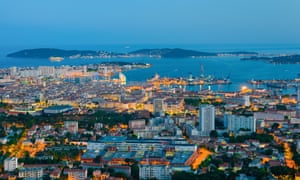
So there’s a choice: base yourself at the beach and ride the ferry into the city for shopping and culture, or stay in the buzzy old town and make seaside day trips. Either way, it’s a 25-minute ferry ride between the port (bottom of rue d’Alger) and the wide sandy beach of Les Sablettes, with the Fernand Braudel botanical garden. From here the coast path runs around Cap Sicié headland, passing other beaches and coves, including small, shingly La Verne, and Fabrégas, with black volcanic sand. Water sports lovers can explore on a paddleboard or kayak from Sablettes yacht club.Ferries also run to the peninsula of Saint-Mandrier, which has beaches on its southern coast and a cute marina on its city side, and there are more sandy bays in the upscale eastern suburb of Le Mourillon (bus 3 from Boulevard Strasbourg). The former fishing hamlet of Anse Mejean is particularly special: a semicircular bay of gin-clear water tucked under Cap Brun fortress and home to L’Escale, a waterside restaurant run by a former Toulon rugby star. (It’s usually possible to walk there from Le Mourillon, but the coast path is undergoing major reconstruction this year; take a taxi.)

Toulon old town is vibrant thanks to a scheme offering tax breaks to young startups: atmospheric streets are lined with small seasonal bistros, vintage shops and galleries. The authorities also recently reopened formerly bricked-up alleyways (similar to Lyon’s traboules) under medieval buildings and made all museums (except the Naval History Museum) free. Check out the Asiatic art gallery, photography museum and contemporary Hotel des Arts. And if you’re struggling to get your head around Toulon’s watery geography, ride the cable car to the top of 584-metre Mont Faron (€7.80, take bus 40 to its foot), and it’s all laid out below.
Where to stay
Le Cannier is a feet-in-the-sand fish restaurant (plat du jour €13) run by sisters Nathalie and Emmanuelle Frizzi. Eight simple, fan-cooled doubles (from €75 room-only) on the first floor have balconies overlooking the beach. In town the faded but friendly and central Little Palace has doubles with aircon from €67 room-only. Gîtes sleeping four near Les Sablettes cost from €500 a week, and Camping La Presqu’île has a pool, kids’ club and mobile homes from €420 for four (check for last-minute deals).
Where to eat

In Fabrégas, Il Gusto (formerly Chez Didier) does Italian food and a Friday grand aioli (the Provençal dish of fish, shellfish and veg with garlicky mayonnaise). Of several beach restaurants at Le Mourillon, La Note Bleue is a good bet, specialising in barbecued local fish. In town, tiny Le Baron Perché, in a small square near the port, offers a short, daily changing menu including veggie mains and Corsican specialities.
Rovinj, Croatia
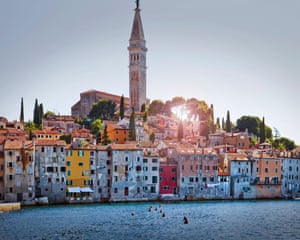
Ideally, your first glimpse of Rovinj should be from the Adriatic. Then you’ll see the elegant bell tower of the baroque church of St Euphemia rising above a sea of terracotta rooftops and pastel-coloured houses. But however you arrive (the nearest station, Kanfanar, is 15 minutes away, while Pula airport is 40 minutes south) the charms of what is undoubtedly Istria’s prettiest coastal town will soon be obvious.
The Venetians left their mark on Rovinj after five centuries of rule – the Italians, too, from 1918 to 1947. The Istrian peninsula is officially bilingual, signs pointing to Rovigno as well as Rovinj. Perhaps because the old town was an island until 1763 when the channel was filled in, the medieval cobbled alleys and charmingly minute squares haven’t really changed. It’s one of the chief pleasures of the town – just wandering along the lanes before finding one that takes you to the water’s edge.
One alleyway to look out for is Ulica Grisia, which is lined with artists’ workshops and galleries. On the second Sunday in August it turns into one long open-air art gallery.
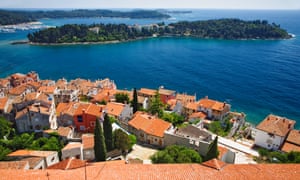
While the old town’s peninsula is ringed with rocky swimming areas, including a series of concrete steps creating a beach near St Euphemia, the best beaches are to the south. Outside two of Rovinj’s poshest hotels, Monte Mulini and Hotel Lone, is a sheltered bay with pebbly beaches along with very smart sunloungers available for rent. From here cycle and hiking paths through Zlatni Rt lead to more secluded beaches as well as a rock-climbing area on the western side of the cape.
The sprinkle of islands around Rovinj makes for a satisfying day – or evening – trip. The island of Sveta Katarina is a 10-minute boat ride away (£3.65 return), and offers a dreamy view of Rovinj that’s even more wonderful at sunset. Crveni Otok (Red Island), a 20-minute boat ride away (£5 return), is a relaxing place to swim, snorkel and stroll through forest trails. It’s actually two islands joined by a causeway, and, with no cars, it’s a sublimely peaceful spot. But pack some swimming shoes to make the most of the pebbly and rocky beaches.
Where to eat
Leave the harbourside restaurants to the other tourists and book ahead for La Puntulina (mains from £18), where a small terrace overlooks a rocky beach near St Euphemia. The cuisines of Italy and Istria are fused so closely that it’s hard to know where one ends and the other begins. That translates into a lot of truffles – with ravioli, steak, pecorino cheese or sea bass – as well as grilled langoustines, prawns and octopus. Tucked away in a narrow alley, Mali Raj (mains from £12), serves pasta, risotto and grilled meats and seafood on a vine-covered terrace.
Where to stay

Set in a restored townhouse, intimate little Melegran has the feeling of a boutique hotel and is on a cobbled lane in the middle of the old town.
Getting there
Probably the nicest way to arrive in Rovinj is to take a train to Venice then a ferry from San Basilio terminal (2hr 45min).
Mary Novakovich
Cagliari, Sardinia
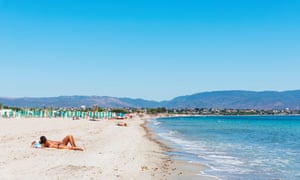
“And suddenly there is Cagliari: a naked town rising steep, steep, golden-looking, piled naked to the sky …” So wrote DH Lawrence in 1921 on sailing to Sardinia. Almost 100 years later the city that made the writer “think of Jerusalem” is just as impressive.
The Phoenicians had a trading port here in the eighth century BC, and the city was later fought over by Carthaginians, Romans, Pisans, Spanish and Piedmontese. How these various invaders felt about sunshine, white sand and turquoise sea is not recorded, but they could get them all at Poetto beach, five miles of palm-lined splendour a 15-minute bus ride from the centre (route PF or PQ, €1.20).
Get off at Via Gorgona for toddler-friendly shallow sea, or stay on three stops to 16th-century Torre Spagnola: beyond here there is a couple of miles of “free beach”. The seafront path is well-used by joggers, rollerbladers and cyclists; there are also diving and sailing clubs, beach volleyball and more.
Poetto is long enough not to feel too crowded even in August, and the water stays warm well into autumn. On summer evenings it’s buzzing as city workers hit its bars and fish restaurants. Behind is Molentargius natural park, with lagoons, flamingoes and bikes to hire.

For a break from the beach, or for those who don’t want to lie in the sun, Cagliari has more cultural offerings than might be expected from a city of 150,000 people. The former Royal Arsenal is now the Citadel of Museums, home to the national art gallery (good for contemporary Sardinian artists) and museum of archaeology plus an Asian gallery, an ethnographic museum and a startlingly graphic museum of anatomical waxworks.
Nearby, Cagliari’s Roman amphitheatre (€3) is being restored: there is talk of a Unesco listing, though for now it’s still untidy and crumbling. Below it, the university botanical garden (€4) is cool and shady on a hot day.
The granite and limestone St Remy bastion, built in 1896, has curving steps to a vast terrace with benches and palm trees, home to a Sunday flea market. The covered promenade beneath has been restored as an art space. Behind it, steep Via dell’Università leads back several centuries into the medieval old town, Castello. Torre del’Elefante, built in 1307, with a little stone elephant carved into one side, used to guard its western entrance. Visitors can climb this and Torre di San Pancrazio on higher ground to the north, for amazing views (€4 each).
A short walk away, via alleys barely wide enough for a Fiat Cinquecento, is Cagliari’s 12th-century cathedral, with its striking pale gold facade of stacked arches. The old town hall across the square also holds contemporary art exhibitions.
Where to eat
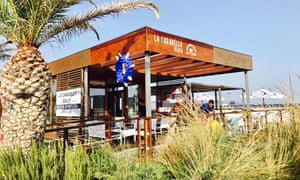
Cruise ships put in regularly at Cagliari, and restaurants in the streets between the port and the old town cater for this captive clientele. A better bet is the Villanova district, on the eastern flank of Castello’s hill. Its 18th- and 19th-century squares and streets are pleasant to wander, and home to gems such as Locanda dei Buoni e Cattivi (Inn of the Saints and Sinners), which does Sardinian slow food specialities such as clams with spicy confit tomatoes, and an exquisite artichoke with soft egg yolk in filo pastry.
For a cheaper dinner, Pizzeria Il Fantasma up the pedestrianised street does great pizzas and antipasti at outdoor tables. Of Poetto’s many “beach clubs”, one of the best is La Caravella, which does great things with tuna, clams and bottarga (three-course lunch €25), as well as pizzas in the evening (from €5.50).
Where to stay
The Buoni e Cattivi has five rooms (from €85 B&B) and three self-catering apartments sleeping four (from €80 a night, in houses nearby. Set around an elegant interior courtyard, Hostel Marina has spacious dorms with single beds (from €20) and no bunks. Or float off to sleep on a nine-metre motorboat moored in the small marina south of Poetto (en suite cabin from €85).
Getting there
Ferries run to Cagliari from Civitavecchia (near Rome), Naples and Palermo. There are also ferries to other Sardinian ports from Genoa, Livorno, Toulon and Marseille.
LB
Volos, Greece

Like most mainland ports in Greece, Volos isn’t especially pretty. But this lively university town —the gateway to the islands of Skiathos, Skopelos and Alonissos— has a lot going for it. Ancient history, modern culture, and a fantastic food scene make Volos an attractive base for exploring one of Greece’s most stunning coastlines: the Pelion peninsula just to the east.
You’ll barely bump into any other foreigners in the backstreets behind Volos harbour. But you will find a handful of intriguing landmarks: the handsome Archaeological Museum, brimming with neolithic and paleolithic artefacts; Volos City Museum, which recounts the lives of local tobacco workers, footballers, and refugees through photographs and household objects dating back to the 1800s; and the old Tsalapatas tile and brick factory, a monument to the city’s industrial heritage, which doubles as an exhibition and events space.
Wandering around the old quarter of Palia is like peeling back the layers of the city’s long history. There are ancient amphorae left in situ by archaeologists, an Ottoman gunpowder depot, a Byzantine castle, and the loveliest train station in all of Greece —a yellow building with carved green woodwork built in 1884. Apartment blocks have become a canvas for Greek and international graffiti artists. Pick up a map of the city’s 40-odd murals from the tourist information office, or book a walking tour with Pelion Culture (pelionculture.gr), led by local archaeologist Yota Pantou.
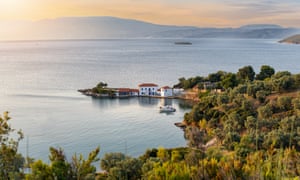
Flat and compact, Volos is easy to explore by bicycle. Join the locals freewheeling along the seaside esplanade to the city beaches that begin at Anavros. Or push on to the lush Pelion peninsula, which crooks its finger into the glassy sweep of the Pagasitikos Gulf. The tree- and taverna-lined beaches on Pelion’s south side are sheltered from the winds. Those nearest to town — Gatzea, Kala Nera, Boufa, Lefokastro — can get crowded, especially at weekends. Young guns and high rollers head to the beach bars poking out of the pine trees at Afissos. Families prefer sandy Milina, where you can take a boat trip to the tiny islands of Alatas and Prasouda, or all the way to snoozy Trikeri, adrift off Pelion’s southern tip.
Mountainous Pelion has its wild side, too. From Volos, it’s a winding drive over wooded ridges and through stone hamlets to the Aegean coastline, where the road drops down to wide-open beaches and bright green coves hemmed in by cliffs.
Where to stay
Most hotels in Volos seem to be stuck in the 1980s. Aegli (doubles from €90 B&B) is the exception having been renovated in 2016. The best rooms have balconies overlooking the port. At the Domotel Xenia Volos (doubles from €125 B&B), the dreary interiors don’t quite live up to the 1960s architecture; but the beachfront location is a knockout.
Where to eat
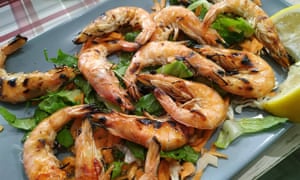
Pick up red pepper pie, olive biscuits and tsoureki (Greek brioche) from Palios Fournos bakery (56 Krokiou Street, Palea) for a picnic on the beach. Around 2pm, Volos comes to a standstill as locals hit their favourite tsipouradiko. There are literally hundreds of these ouzo-and-meze bars in Volos, mostly no-frills, neon-lit joints where Anthony Bourdain would have felt at home.
Each karafaki (little bottle) of tsipouro, a grape distillate that comes with or without aniseed, is served with a titbit or two. You don’t order – the chef-patron just brings a succession of (mostly fishy) delights, that get more generous with each round of drinks. Try Demiris for fresh sea urchin and scallops, or To Filaraki (Averof 3 Nea Ionia), where you’ll be treated to cured mackerel, char-grilled octopus, and the perfect potato salad. Call it a night with an ice cream sundae at Minerva(Argonafton 53), a classic seaside café that stays open all hours.
Getting there
Volos railway station is close to the harbour and served by local trains from Larissa (38 miles away), which is on the main Athens-Thessaloniki line. From Thessaloniki there are trains to Belgrade, Sofia and beyond (the Belgrade route is only open this year until 16 September, see seat61.com). EasyJet flies to Volos (Nea Anchialos airport, 40km away) twice a week.
Rachel Howard
Ostend, Belgium
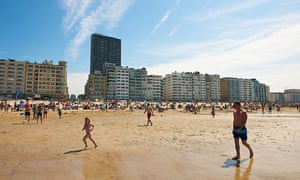
Ostend is called koningin der badsteden (queen of the coast), a nickname that evokes its majestic belle époque hotels and villas. Most of these were destroyed in the second world war, but there are still jewels from the era such as the 1883-built Wellington Racecourse, which holds regular race meetings, and the 1907 railway station, where most visitors arrive.
Other historic attractions include the spectacular neo-Gothic St-Petrus-en-Pauluskerk church, with its ornate twin towers. Its design was inspired by Cologne cathedral, but despite appearances it was actually built just over 100 years ago. Out of town to the south-west, the open-air Atlantic Wall Museumis a major attraction, if a sombre one, with its 60 German second world war bunkers. Happily, it is next to the recently renovated Raversyde scenic area.
From the station, it’s a 10-minute walk to the four-and-a-half-mile-long beach: its western end is backed by high-rise buildings but the sand is lovely and can accommodate thousands. In summer, trains to Ostend are always packed with daytrippers carrying beach paraphernalia and filling the carriage with holiday vibes. Towards the harbour a cluster of beach bars opens in summer, offering cocktails, tapas and music in the shade of palm trees and white umbrellas.
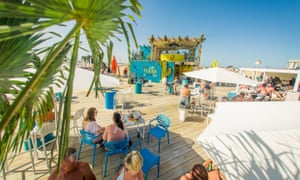
Belgium’s largest coastal city is riding a wave of renewal. Until about 10 years ago, this queen was looking decidedly shabby, but today it oozes cool, thanks to events such as Crystal Ship, an annual arts festival transforming the streets and buildings with vivid murals and installations. This year’s edition added 10 new permanent artworks.
A 10-minute walk from the railway station a former post office from 1947 is now a popular cultural centre called De Grote Post, with arts events in its side rooms. The main hall has been restored beautifully to its former glory, and everyone comes here for coffee or a bite to eat in the popular CultuurCafé. Try the geitenkaas (goat’s cheese) encased in brickdeeg (literally “brick dough”).
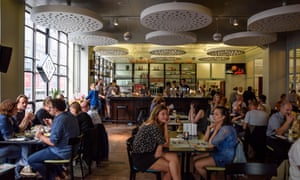
East of the centre and port, Oosteroever is a quieter, more natural stretch of beach, dominated initially by the 1811-built Fort Napoleon. It can be reached by car or bike, but it’s more fun to take the free ferry that departs from near the Vistrap, the fish market. Buy some shrimps from one of the stalls (€3) and hop on. It doesn’t get more Ostend than this. At Oosteroever, a walkway on the top of the Oostelijke Strekdam (Eastern Breakwater, part of the harbour defences) leads out into the sea. Near the foot of the Oostelijke Strekdam, the Phare East sailing club offers kayaking, surfing, windsurfing and kitesurfing.
Where to stay

The new industrial-chic Upstairs Hotel (doubles from €65 room-only) is a 15-minute walk from the station and right behind the beach on Hertstraat. The lobby has table tennis, table football and a yellow slide popular with children (and adults). Between the beach and the harbour channel, the recently renovated Providence by Getaway (two-bed studios from €52), also enjoys a prime location and hip coastal vibes.
Where to eat
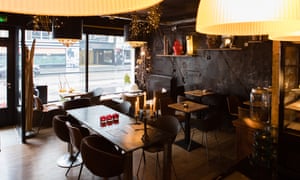
Ostend used to be associated with tourist traps – the coast road, Zeedijk, was brimming with them – but a slew of excellent new restaurants has opened. Sanseveria, a 10-minute walk from the station, serves great bagels and salads (€13.50 for bagel, dessert and a drink) and is run by Bert Vanheuverzwijn, who used to work at Michelin-starred Hof van Cleve near Ghent. The cosy interior is decorated with his grandparents’ furniture.
The coffee comes with homemade chocolate cookies. Another newcomer is Expo & Kafie, right behind the Zeedijk. The breakfasts feature Greek yoghurt and honey, artisanal bread, eggs, bacon and smoked salmon (from €10). This summer Chez Paulette opened Panorama on the roof of De Grote Post. The bar/restaurant has superb views and serves great homemade drinks (beetroot, ginger and carrot €6.50) and cocktails (€12), and dishes such as cod with smoked mozzarella and fresh herbs (€28). Delightful tapas too, from €9. Be aware that Panorama shuts in strong winds.
For something more traditional, try the The Old Inn , a five-minute walk from De Grote Post towards the beach. There are just two dishes on the menu at this delightful restaurant with walls covered in antique posters of Ostend: steak (€23) or fish (catch of the day, price varies). Annie started this business in 1969 and still reigns supreme in the kitchen. Her husband René brings the hand-cut fries and homemade mayonnaise to your table. Desserts (€7) are local classics dame blanche (ice-cream with hot chocolate sauce) or pancake mikado (my favourite).



